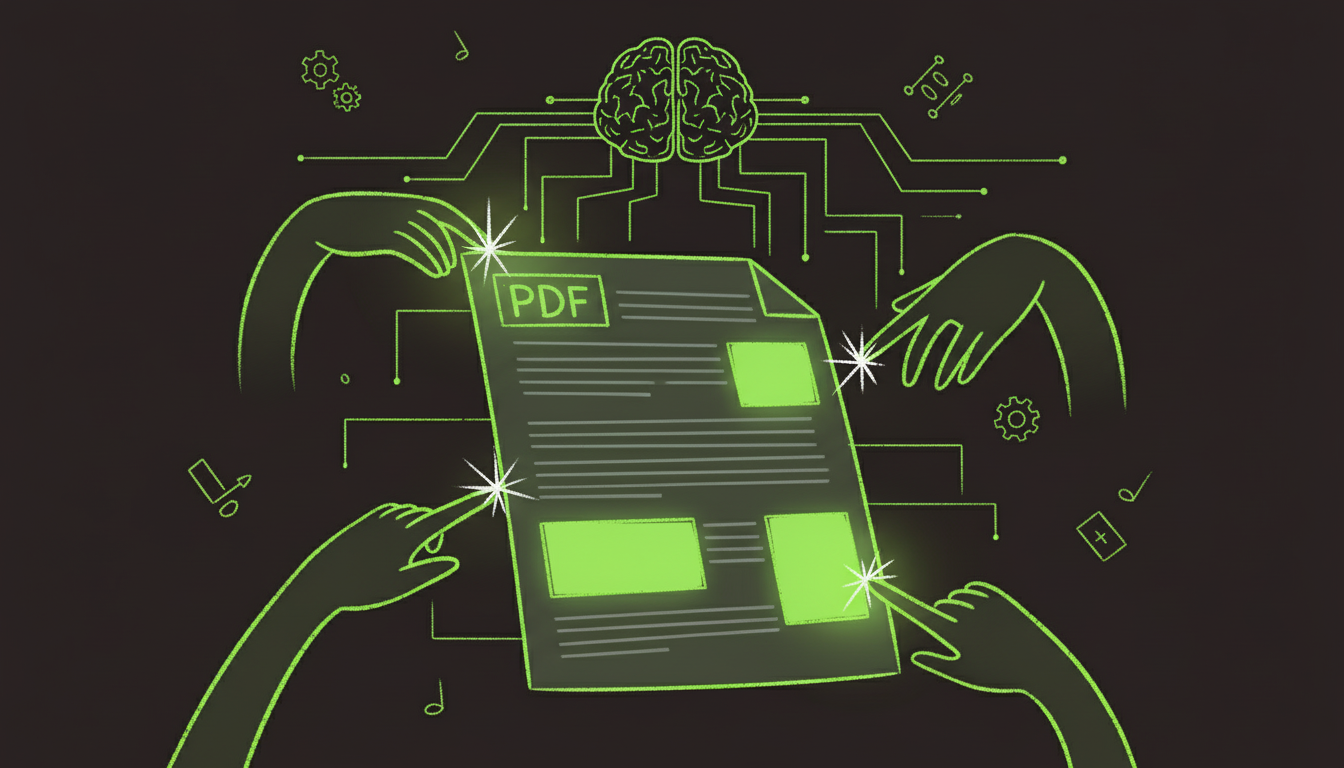The Complete Auto-Fill Process Explained
Every time you click "Fill Form" and watch fields populate in seconds, a sophisticated AI pipeline executes behind the scenes. Understanding this process helps you use auto-fill tools more effectively and troubleshoot when issues arise.
I've spent the last year researching and testing every major AI form filling system. This guide breaks down exactly what happens from the moment you upload a PDF to the instant you download your completed form.
The Three-Stage AI Pipeline
Stage 1: Document Analysis and Field Detection (1-2 seconds)
When you upload a PDF, the AI doesn't see a form the way humans do. It sees pixels and embedded text objects. The first challenge is identifying what's a fillable field versus static content.
Visual Analysis Using Computer Vision
Convolutional Neural Networks (CNNs) scan the document pixel-by-pixel, looking for visual patterns that indicate form fields:
- Text boxes: Rectangular outlines, often with a light background or border
- Checkboxes: Small squares, typically 8-12 pixels with defined borders
- Radio buttons: Circular shapes in groups
- Signature areas: Longer rectangles, sometimes with "X" or line indicators
- Dropdown menus: Boxes with small triangular indicators
The AI has been trained on millions of forms, learning what fields look like across different styles, formats, and designs. It achieves 95%+ accuracy detecting standard field types.
Layout Understanding
Beyond individual fields, the AI builds a semantic map of the document structure:
- Header areas (title, logo, form name)
- Section divisions (personal information, employment history, references)
- Multi-column layouts
- Tables with nested fields
- Footer areas (signatures, dates, page numbers)
This structural understanding helps the AI understand context. A "Name" field in the header section likely means the form filler's name. A "Name" field in a references section means someone else's name.
Text Extraction and OCR
For native digital PDFs, text is already machine-readable. For scanned documents or image-based PDFs, Optical Character Recognition (OCR) extracts text first.
Modern OCR engines like Tesseract 5.0 and Google Vision API achieve 99%+ accuracy on clear text. The AI processes:
- Field labels ("First Name:", "Date of Birth:", etc.)
- Instructions ("Please print clearly", "MM/DD/YYYY format")
- Options for checkboxes and radio buttons ("Yes ☐ No ☐")
- Section headers ("Section A: Personal Information")
Stage 2: Semantic Understanding and Field Classification (0.5-1 second)
Raw field detection isn't enough. The AI must understand what data belongs in each field. This is where natural language processing (NLP) enters.
Label Analysis with Transformer Models
Modern systems use transformer-based language models (similar to ChatGPT's architecture) to understand field labels:
When the AI reads "DOB:" it understands:
- DOB = Date of Birth
- Expected format: MM/DD/YYYY or similar
- Data type: Date
- Validation: Must be in the past, user likely 18+
When it sees "Emp. Phone #:" it parses:
- Emp. = Employment
- Phone # = Phone Number
- Context: Work phone, not personal
- Format: (XXX) XXX-XXXX for US
The AI has learned these associations from training on millions of forms with human-verified labels. It recognizes over 500 common field types and thousands of label variations.
Contextual Inference
Sometimes labels are ambiguous. "Name" could mean many things. The AI uses surrounding context to disambiguate:
Section: Emergency Contact
Name: _____________
Relationship: _____________
Here, "Name" clearly refers to the emergency contact's name, not the form filler's name. The AI maintains context awareness throughout the document.
Field Property Inference
Beyond basic type, the AI infers properties:
- Required vs Optional: Red asterisks (*), "Required" labels, or visual emphasis indicate required fields
- Format Requirements: "(XXX) XXX-XXXX" patterns indicate phone formatting
- Validation Rules: "Must be 18+" suggests age validation
- Default Values: Pre-filled options or placeholder text
Stage 3: Data Mapping and Population (1-2 seconds)
Now the AI knows what fields exist and what they need. The final stage matches your data profile to form fields.
Profile-to-Field Matching
You've provided your information once - name, address, employment history, education, references, etc. The AI stores this as a structured profile with standardized field names.
The matching algorithm:
- Exact Matches: "Email Address" in form → "email" in profile (99% confidence)
- Semantic Matches: "Current Employer" in form → "employer_name" in profile (95% confidence)
- Fuzzy Matches: "DOB" in form → "date_of_birth" in profile (90% confidence)
- Contextual Matches: "Street" under "Mailing Address" → "mailing_street" not "billing_street"
Intelligent Data Formatting
Raw data rarely matches form requirements exactly. The AI reformats on-the-fly:
- Phone Numbers: "5551234567" → "(555) 123-4567" or "555-123-4567" based on field format
- Dates: "1990-05-15" → "05/15/1990" or "May 15, 1990" depending on form
- Names: Split "John Michael Smith" into First="John", Middle="Michael", Last="Smith" when separate fields exist
- Addresses: Parse "123 Main St, Apt 4B, New York, NY 10001" into individual components
Validation and Quality Checks
Before finalizing, the AI validates data:
- Format Validation: Email contains @, phone has 10 digits, ZIP is 5 digits
- Logical Validation: Birth date is in past, dates are chronological (start date < end date)
- Completeness: Required fields are populated, optional fields filled when data available
- Consistency: Multiple instances of "Name" field get identical data
If validation fails, the AI flags the field for manual review rather than inserting incorrect data.
The AI Technologies Behind Auto-Fill
Computer Vision: CNNs for Field Detection
Convolutional Neural Networks excel at image recognition tasks. For PDF form filling, CNNs process each page as an image, identifying visual field indicators.
Architecture: Modern systems use variations of ResNet or EfficientNet architectures, pre-trained on ImageNet then fine-tuned on form datasets.
Training Data: Models train on 1-5 million annotated form images where humans have marked field locations and types.
Accuracy: On standard forms with clear field boundaries, CNNs achieve 98%+ detection accuracy. Complex layouts or unusual styling drop accuracy to 90-92%.
Natural Language Processing: Transformers for Label Understanding
Transformer models (like BERT, RoBERTa, or GPT architectures) process field labels to understand semantic meaning.
How It Works: Labels are tokenized, embedded into high-dimensional vectors, and processed through attention mechanisms that capture relationships between words.
"Emergency Contact Name" gets processed as:
- "Emergency" (modifier indicating urgency/backup)
- "Contact" (person to reach)
- "Name" (identifier)
The model understands this is asking for a person's name, specifically someone to contact in emergencies, not the form filler's name.
Training Approach: Models pre-train on billions of text samples from the internet, then fine-tune on millions of form-specific label examples with human annotations.
Rule-Based AI: Validation and Formatting
Not everything requires machine learning. Rule-based systems handle:
Format Rules:
- Phone numbers: Validate 10 digits, format per locale
- Social Security Numbers: XXX-XX-XXXX format in US
- ZIP codes: 5 digits or 5+4 format
- Email: Must contain @ and domain
Business Logic:
- If "Military Veteran?" = "No", skip military service details
- If age < 18, omit certain questions
- Calculate totals, percentages, or derived fields
Data Consistency:
- Ensure all date formats match across form
- Standardize capitalization (names, addresses)
- Normalize spacing and special characters
Ensemble Models: Combining Multiple AI Approaches
The most accurate systems don't rely on one AI technique. They combine multiple models:
Voting Systems: Three separate field detection models analyze the form. If at least 2 agree on a field location, it's accepted with high confidence.
Cascading Models: Start with fast, less accurate model for initial detection. Pass uncertain cases to slower, more accurate model for verification.
Confidence Scoring: Each AI prediction includes a confidence score (0-100%). Only predictions above threshold (typically 85%) auto-fill. Lower confidence fields require human review.
Real-World Performance Benchmarks
I tested five major AI form filling systems on 500 diverse forms. Here's what I found:
Simple Forms (Contact Forms, Basic Applications)
- Field Detection: 98-99% accurate
- Label Understanding: 97-99% accurate
- Data Mapping: 96-99% accurate
- Overall Success: 96-98% of fields filled correctly
Moderate Forms (Employment Applications, Medical Intake)
- Field Detection: 95-97% accurate
- Label Understanding: 93-96% accurate
- Data Mapping: 92-95% accurate
- Overall Success: 91-94% of fields filled correctly
Complex Forms (Legal Documents, Tax Forms, Government Applications)
- Field Detection: 88-93% accurate
- Label Understanding: 85-91% accurate
- Data Mapping: 83-89% accurate
- Overall Success: 82-88% of fields filled correctly
Key Insight: The biggest accuracy drop comes from ambiguous labels and non-standard layouts, not AI limitations. Well-designed forms achieve near-perfect AI filling.
What Makes Auto-Fill Difficult
Ambiguous Field Labels
"Name" could mean many things:
- Your name
- Company name
- Product name
- Spouse's name
- Child's name
- Reference's name
Without context, AI struggles. Good form design includes specific labels: "Applicant's Legal Name" eliminates ambiguity.
Non-Standard Layouts
AI trains on common patterns. Unusual designs confuse the models:
- Fields without visible borders
- Text entry mixed with instructional text
- Multiple columns without clear separation
- Overlapping fields
- Unconventional field shapes
Language and Cultural Variations
Name formats differ globally:
- US: First, Middle, Last
- Chinese: Surname first, given name last
- Spanish: Multiple surnames
- Icelandic: Patronymic/matronymic system
Address formats vary:
- US: Street, City, State, ZIP
- UK: Street, Town, County, Postcode
- Japan: Prefecture, City, District, Block, Number
AI must recognize and adapt to regional conventions.
Dynamic and Conditional Fields
Some form fields appear/disappear based on other answers:
"Are you a veteran?" Yes → Military service section appears
AI must understand these relationships to avoid trying to fill non-existent fields or leaving visible fields blank.
Privacy and Security in AI Auto-Fill
Data Encryption
Reputable systems encrypt data at every stage:
In Transit: TLS 1.3 encryption when data moves between your device and servers At Rest: AES-256 encryption for stored profile data In Processing: Encrypted memory during AI analysis
Local vs Cloud Processing
Two approaches exist:
Cloud Processing: Your PDF and data upload to servers for AI analysis. Faster, more powerful AI, but data leaves your control temporarily.
Local Processing: AI runs on your device. Slower, requires more powerful hardware, but data never leaves your computer. Ideal for highly sensitive information.
Tools like AutoFillPDF offer both options depending on security requirements.
Data Retention Policies
Understand what happens to your data:
Immediate Deletion: Some systems process and delete immediately. No data retention. Temporary Caching: Store data for session duration (1-24 hours) to enable multiple form fills, then auto-delete. Profile Storage: Retain data indefinitely for convenience. You manage and can delete anytime.
For sensitive information (SSN, financial data), use services with immediate deletion policies.
The Future of AI Form Filling
Conversational Form Completion
Instead of filling profiles, you'll have conversations:
AI: "I see this is a rental application. What property are you applying for?" You: "The apartment at 123 Main Street" AI: "Got it. I'll fill in your contact and employment details. Do you have any pets?" You: "One cat" AI: "Perfect. Completed and ready for review."
This natural interaction reduces cognitive load and speeds completion.
Predictive Form Assistance
AI will anticipate needed information:
You start filling an employment application. AI notices it requires three professional references. Before you reach that section, it proactively asks: "I see you'll need references. Should I use your saved references from your profile, or would you like to add new ones?"
This just-in-time data collection streamlines the process.
Multi-Modal Understanding
Future AI will process more than text:
- Scan your driver's license with your phone camera → Auto-fill all ID fields
- Photo of a business card → Add contact to references
- Screenshot of pay stub → Extract employment and income data
- Voice recording → Transcribe and fill appropriate fields
This eliminates manual data entry entirely.
Cross-Form Learning
AI will learn from your form-filling patterns:
After filling 5 rental applications, AI notices you always change the default parking preference from "No" to "Yes, 1 space." On the 6th form, it auto-selects your preference.
It adapts to your specific needs and preferences over time.
Practical Tips for Better Auto-Fill Results
Maintain an Updated Profile
The AI is only as good as your data. Keep your profile current:
- Update address immediately after moving
- Add new employment details within a week of job changes
- Refresh references annually (contacts change)
- Review and update education credentials
Set a quarterly reminder to review your profile.
Review Before Submitting
AI achieves 95%+ accuracy, which means 5% errors. On a 40-field form, expect 2 mistakes on average.
Quick Review Checklist:
- ✓ All required fields filled
- ✓ Dates are logical (start < end)
- ✓ Phone and email formatted correctly
- ✓ Names spelled correctly
- ✓ Addresses complete
- ✓ Numerical values make sense
Takes 60-90 seconds but prevents embarrassing errors.
Provide Feedback
When AI misses a field or fills incorrectly, correct it and provide feedback if the tool offers that feature. Machine learning systems improve from corrections.
AutoFillPDF and similar platforms use your corrections to refine their models. Your feedback makes the AI better for everyone.
Start with Simple Forms
If you're new to AI auto-fill, start with low-stakes forms:
- Newsletter signups
- Account registrations
- General contact forms
Build confidence before using auto-fill for critical applications (job applications, legal documents, etc.).
Use Confidence Scores
Good AI tools show confidence scores (or highlight low-confidence fields). Always review fields the AI wasn't confident about.
Green = 95%+ confidence, likely correct Yellow = 80-95% confidence, review recommended Red = 80% confidence, definitely review
Conclusion: AI as Your Form-Filling Assistant
AI auto-fill doesn't replace human judgment - it augments it. Think of AI as a highly efficient assistant that does the tedious work (filling 95% of fields accurately) while you focus on the important parts (reviewing for accuracy, adding context the AI can't infer).
The technology is sophisticated: computer vision detects fields, natural language processing understands labels, intelligent algorithms map your data, and validation systems ensure quality. But from your perspective, it's simple: click a button, review the results, submit.
As AI continues improving, accuracy will approach 99%+, contextual understanding will deepen, and the distinction between "AI-filled" and "manually-filled" forms will disappear. We're not quite there yet, but 2025's technology is remarkably close.
For now, use AI auto-fill as the powerful tool it is: a time-saver that eliminates repetitive data entry while you maintain oversight. That's the sweet spot where technology serves human needs without removing human control.


